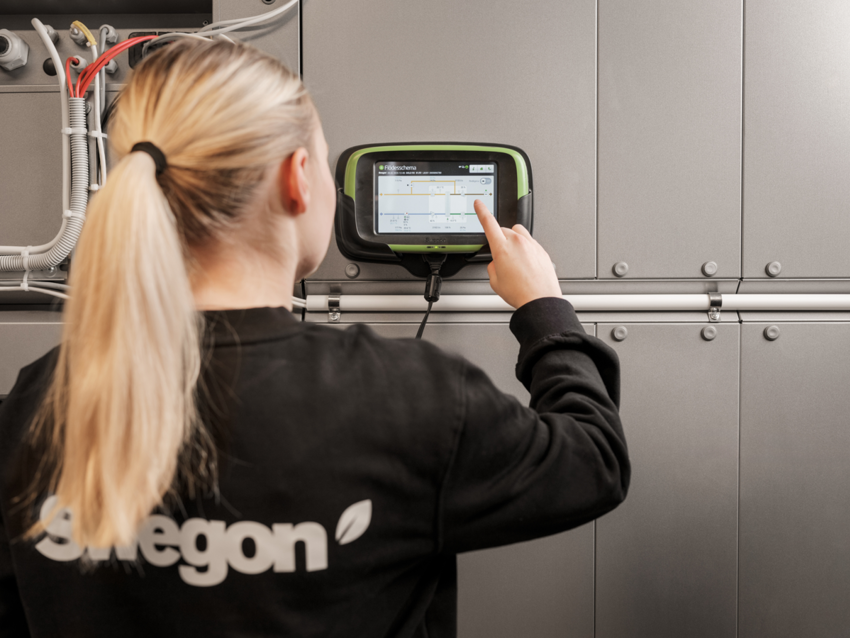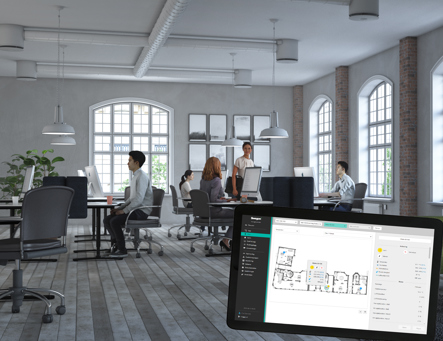Hospitals and care rooms as examples for air quality and temperature
Hospitals and care rooms are used as examples in this guide as we put air quality and temperature in public buildings in the spotlight. To ensure good air quality and a comfortable temperature is vital in almost any building, but hospitals serve as a good example for us to apply our insights and share our recommendations.
Health, comfort and productivity
Many take great care about what they eat and drink to stay healthy and productive, but the air they breathe is rarely given much thought. Historic health risks of fuming fireplaces and indoor smoking have successively been eliminated, but research shows that the indoor climate still can affect us negatively. Today, buildings and various tangibles, plastics and electronics, cause health issues due to the way they give off particles and excess heat to the indoor environment. Humans also affect the indoor climate as we emit heat from our bodies, particles and fibres from our skin and clothing, and we may spread virus and bacteria.
In terms of a hospital, many patients’ visits are brief but unfortunately some patients return regularly or even stay for longer. Care units and elderly homes have patients remaining permanently, and all along, these indoor spaces are the workplaces of very many people who’s productivity and readiness is indispensable. It is therefore important that the indoor climate is healthy and comfortable, supports patients’ recovery and everyone’s well-being.
Learn more about why the indoor climate matters

Air quality
To ensure good air quality, it is important to extract the used air from the indoor environment and supply it with new air. Hence, ventilation is needed and air handling units are key.
The air handling unit (AHU) extracts the stale air from the inside, and when doing so, minimises the risk of virus and bacteria to spread. At the same time, the air handler brings outdoor air in, filters it thoroughly and supplies it to the indoor space. From an energy efficiency point of view, air handling units are most often provided with equipment for energy recovery, usually called heat exchangers. In the context of designing indoor climate solutions for hospitals, it is essential to know that different types of heat exchangers suit different air quality requirements – clean rooms and operating theatres included.
Two recommendations for air handling units
Product selection software
So, it is clear that there is an essential need for ventilation in hospitals and that air handling units (AHUs) is a must. There are numerous variants on the market and it may feel overwhelming to make a choice. We then have two recommendations from Swegon – use product selection software and make long term decisions.
Most product selection software are highly sophisticated and allow for users to make advanced performance and energy calculations, and a wide range of project relevant data can usually be generated. What makes a software stand out, is how it allows for easy tweaks and changes in configurations over an entire product range, and how it enables significantly more details in its technical output. Get familiar with our Swegon software and explore our range of products through them.
See our complete range of air handling units
More about product selection software in our blog postI get an early understanding of flow rates, and it’s easy to test different solutions and configurationsSam Shulver, a Principal Engineer at Skelly & Couch, about why he prefers to work with product selection software like AHU Design from Swegon

Long term decisions
To make long term decisions is far from only reflecting upon an investment in relation to a projected lifespan. A long term decision is to ensure that selected products and systems can allow for possible future changes, inside and outside, and still meet the set requirements for a good indoor climate, and do so in an energy efficient manner.
With the above said, consider air handling units with a broad range of functionalities, focus on the ones that can be connected to various indoor climate systems for demand controlled ventilation (DCV) and such. Also, concentrate on products which offer the opportunity to upgrade in the future for a longer service life.
See our reference case, NÄL Regional Hospital in Trollhättan, Sweden
Learn more about demand controlled ventilation (DCV)Units for examination rooms and care units
PARAGON
So, when the air handling units are selected and the air quality requirements are met, it is time to make sure that the exchange of air takes place in a way that does not entail draughts or short-circuit flows.
Thermally controlled ventilation should not be excluded as an alternative for a hospital but it will be more common to apply the principle of mixing ventilation. A wide range of air diffusers and comfort modules can be used for mixing ventilation, but a few ones should be mentioned specifically - PARAGON, COLIBRI Ceiling and OPL. PARAGON is a comfort module which distributes air in one direction, and it is especially designed for creating a good indoor climate in care units and examination rooms. It is an adaptable product in the way that it can be adjusted to individual or situational needs. PARAGON is a waterborne product, dependent on a hydronic system.
Learn more about indoor climate in care rooms
See our PARAGON products hereHigh performance, long-term and various design options
COLIBRI
Our COLIBRI ceiling air diffuser is a good choice for hospitals' och care units' indoor spaces which have been assigned "normal" indoor climate requirements. The product's many adjustable nozzles allow for fast mixing of the air, and one of the many advantages lies in its adjustability. The product can allow for changes in the indoor environment and still perform excellently without causing uncomfortable draughts.
Colibri ceiling is also an attractive product from a design perspective. It is available as circular and rectangular, and both as supply and extract air diffusers. Further, it can be provided in nearly any colour, either to stand out or to blend in. All this makes it possible to create either conformity throughout the building and bring a sense of calmness to the indoor environment, or to brighten up a place which otherwise can be both serious and sterile.
More about colibri
When the reqirement is "strictly clean air"
OPL
Clean rooms in a hospital obviously have vastly differing requirements compared to many other parts of the same building. Extremely clean air conditions are critical to prevent patients from being exposed to harmful particles, virus and bacteria, normally that implies a slightly colder temperature than otherwise recommended. However, the indoor climate in an operating theater must provide a pleasant work environment so doctors and surgery staff excellently can perform their work.
The mentioned OPL unit from us at Swegon features HEPA filters which ensure that the air supplied is clean and free of contamination. The unit is also designed for the higher air flow requirements in clean rooms, but features an air flow pattern that avoids draught and chilling effects from the slightly colder temperature in the occupied zone.
Further reading about OPL and clean rooms

Heating and cooling at the same time
Thinking about a large hospital. It is more or less obvious that different indoor spaces will require different temperatures at the same time. The operating theatre will most likely need cooling, while the care rooms sometimes demand heating.
A multifunctional unit which builds on a 4-pipe system is an energy efficient way to solve that requirement. It allows for independent and simultaneous heating and cooling in the building and, provided with heat exchangers, it makes use of the energy already inside the property. In addition, a multifunctional unit can ensure domestic hot water, something that is used quite a lot in a hospital and care environment.
A reference case to familiarise with our OMICRON multifunctional unit
Products
There are several products that can suit the needs of a hospital, health facility or care unit, below are a few suggested links to explore further

Product selection software
Our wide range of assisting software makes the design phase easier

